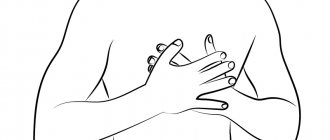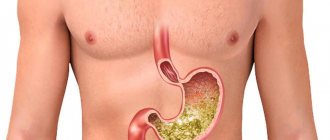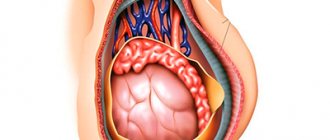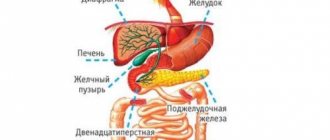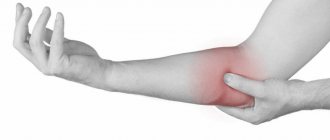Causes of chest pain when breathing
The most common cause of chest pain when breathing is pleurisy. This disease is characterized by inflammation of the lining around the lungs. There are two layers of pleura: covering the inside of the chest and the pleura covering the lungs. Pleurisy, in addition to pain when breathing, can cause coughing, chest tenderness, and difficulty breathing.
In addition to pleurisy, chest pain during breathing can provoke various diseases. The most common causes of the symptom:
- Rheumatoid arthritis;
- Lungs' cancer;
- Mammary cancer;
- Mesothelioma;
- Lupus;
- Pancreatitis;
- Cirrhosis of the liver;
- Connective tissue disease;
- Viruses, fungi, parasites;
- Pulmonary infarction;
- Injuries to the ribs, sternum;
- Pleural tumors;
- Pulmonary embolism;
- Clogged lungs with particulate matter;
- Congestive heart failure.
What kind of pain can there be in the area of the shoulder blades?
The peculiarity of the manifestation of pain may suggest its cause.
Sharp intermittent pain , which often manifests itself when moving, is a sign of pinched nerve roots and heart pain; in more rare cases - the consequences of an inflammatory process, scoliosis, osteochondrosis, or the result of irradiation of pain from internal organs.
A dull aching pain indicates problems with the spine or damage to adjacent soft tissues (osteochondrosis, fibromyalgia, intervertebral hernia). Less commonly, a dull pain may be caused by a stomach ulcer or cardiac ischemia.
Severe, almost unbearable pain may suggest a heart attack (accompanied by loss of consciousness, arrhythmia, surges in blood pressure), pancreatitis (bloated abdomen and additional gastrointestinal symptoms), neuralgia (difficulty breathing), protrusion (bulging) of the intervertebral disc.
There are also special pain sensations that can be identified based on subjective perception:
- stabbing pain – inflammatory diseases of internal organs (pyelonephritis, pleurisy, cholecystitis, peptic ulcer);
- with a burning effect - a sign of coronary heart disease, angina pectoris;
- nagging pain is a possible manifestation of myofascial syndrome (sharp spasm of muscle fibers).
In reality, determining the cause of pain is much more difficult. Nerve endings from a number of internal organs converge in the area of the shoulder blades, so the reasons that your back hurts in the area of the spine between the shoulder blades can be the most unexpected: as they say, the pain in the heel, but it radiates to the head.
In what cases does the back hurt in the area of the shoulder blades when inhaling?
When inhaling, 12 pairs of ribs, the sternum, adjacent parts of the spine and girdle of the upper extremities, the diaphragm, lungs, trachea and bronchi, dozens of controlling muscles, ligaments and fascia are involved in the work, and also affects the heart located in the chest area and the adjacent part of the gastrointestinal tract. It is impossible to answer unequivocally and immediately which of all this diversity provokes painful sensations under the shoulder blade when inhaling.
There are several reasons:
- Inflammatory and degenerative pathologies of the tissues of the spinal column (osteochondrosis, spondyloarthrosis) lead to degradation of cartilaginous discs, and in severe cases, the vertebrae themselves. Damaged tissues become sensitive and respond with pain with any careless movement, including taking a deep breath. This problem is called intercostal neuralgia.
- Congenital or acquired pathologies of the spinal structure (scoliosis, kyphosis) deprive the spine of its shock-absorbing function. The muscle corset weakens and upright walking becomes a problem. In this case, the nerve roots that extend from the spinal cord are pinched during any careless movement and provoke pain of varying degrees of intensity.
- Pneumonia, pleurisy (the lining of the lungs thickens and becomes more sensitive during inflammation, which provokes characteristic painful sensations when inhaling) and heart problems as one of the symptoms have substernal pain in the area of the shoulder blades, which intensifies when inhaling. Inflammation of the respiratory system is most often accompanied by cough, fever and shortness of breath.
- Cardiac pathologies. The worst is myocardial infarction, which is preceded by an attack of angina.
- The deeper the breath, the lower the diaphragm goes, putting pressure on the adjacent liver, pancreas, and stomach. The presence of pathologies in this area (stomach ulcer, pancreatitis, cholecystitis) may be reflected by colic in the thoracic region.
Pain in the shoulder blade on the right and left
The pain is not always located centrally or covers the entire thoracic region. It can shift to the area of the left or right shoulder blade.
If your back hurts in the area of the shoulder blades on the left, this may indicate heart pathologies. Pain in a limited area of the subscapular region indicates pericarditis (inflammation of the pericardial sac). If it diverges from the shoulder blades to the entire left half of the body, angina pectoris or even a heart attack should be suspected. In more rare cases, left-sided pain may be due to a stomach ulcer.
If your back hurts in the area of the right shoulder blade, this indicates radiating pain due to colic of the gallbladder. Blockage of the ducts with gallstones provokes spasm and unbearable pain of a cutting-stabbing type. Very often this problem is accompanied by nausea and vomiting. A rarer variant of right-sided subscapular pain is kidney disease. In acute nephritis or pyelonephritis, the back hurts in the area of the right shoulder blade with an upward direction of pain in the right shoulder and neck. Additionally, the problem is accompanied by frequent urination and “gnawing” pain in the lumbar region.
On a note! With pathologies of the spinal column, your back may hurt in the area of the shoulder blades, both on the right and on the left - it all depends on the location of the pathological process.
Back pain in the shoulder blades and neck
This type of pain is the result of the most common pathology of the spinal column - osteochondrosis. The problem is characterized by a dull aching pain that becomes stronger in the evening and may disappear after a long sleep.
In the early stages of the development of pathology, painful sensations in the area of the shoulder blades and neck can occur due to muscle overstrain. With a weak muscle corset, the vertebral structures are deformed - cervical and/or thoracic scoliosis and kyphosis appear, which, in the absence of timely measures, can cause neuralgia, cerebrovascular accidents, difficulty breathing, as well as intervertebral hernia and premature wear of the discs - spondyloarthrosis.
On a note! Cervicothoracic osteochondrosis has become noticeably “younger”. If previously it was considered a disease of older people, now even primary schoolchildren are susceptible to it. Very often you can find that a child has back pain in the area of the shoulder blades and neck from constantly sitting at home or spending a long time at the computer.
In addition, the back hurts in the area of the shoulder blades and neck due to arthritis of the shoulder joint, stenosis (narrowing) of the spinal canal. Uncharacteristic causes of pain in the cervical-scapular area:
- lymphadenitis caused by tonsillitis (throat and back pain in the shoulder blade area);
- acute herpetic infection;
- a sharp attack of cholelithiasis, radiating to the right shoulder blade and further to the neck;
- acute thyroiditis;
- angina pectoris (heart attack);
- pancreatitis;
- cancer of the lungs with metastases;
- chronic myofascial syndrome.
Diagnosis of chest pain when breathing
Due to the large number of diseases that can cause chest pain when breathing, diagnosis can take a long time. By contacting a therapist, you can receive a referral for an examination, which will include the following techniques:
- Electrocardiography;
- Radiography;
- Laboratory tests;
- Angiography of blood vessels;
- CT (computed tomography);
- Blood and urine analysis;
- Bronchoscopy;
- Sputum culture analysis;
- Biochemical studies for amylase, glucose and LDH;
- Palpation;
- Biochemical markers for the presence of myocardial damage;
- Echocardiography;
- ECG screening method;
- ECG with exercise and at rest;
- Study of thyroid hormone levels;
- Dopplerography of blood vessels.
Causes of pain between the shoulder blades
Taking into account the above, several groups can be distinguished among the causes of subscapular pain:
- lifestyle disorder;
- injuries;
- infectious-inflammatory process;
- diseases of internal organs.
Causes of spinal column pathology that we can control:
- lack of nutrition and microelements (deficiency of calcium, phosphorus, magnesium, zinc, silicon, protein leads to degradation of cartilage and bone tissue);
- inactivity (muscle spasms are observed, weakening of the muscle corset provokes curvature of the spine, hernia);
- hard work with improper load redistribution (provokes premature wear of skeletal structures, muscle pain and injuries);
- frequent hypothermia (triggers the development of an inflammatory process in tissues).
On a note! Separately, it is worth mentioning the hormonal background of the body. If the endocrine system malfunctions, the body may actively lose calcium. This is why women, bodybuilders, and people undergoing steroid treatment have back pain in the area of the shoulder blades. When carrying a child, the situation may also worsen. Against the background of a deficiency of microelements, the load on the muscular-ligamentous apparatus increases, which is why many women have back pain in the area of the shoulder blades even after childbirth.
Treatment of chest pain when breathing
Treatment of this symptom is primarily aimed at the cause of its occurrence. Each disease requires a specific approach.
Treatments for the most common causes of chest pain when breathing:
- Pulmonary embolism - a course of anticoagulants is prescribed or the blood clot is removed during surgery;
- Pneumonia - doctors prescribe a course of antibiotics, inhalations and saline solutions;
- Pleurisy - therapy is usually complex. Doctors prescribe anti-tuberculosis and antibacterial drugs in combination with immunostimulants;
- Pneumothorax - in advanced cases, the patient is admitted to the hospital and the air is sucked out of the lungs;
- Rib melancholy - anti-inflammatory drugs, muscle relaxants and physical therapy are prescribed;
- Angina pectoris - acute attacks are relieved with blockades and painkillers. In addition, diet, β-blockers and acetylsalicylic acid are prescribed.
Treatment
Help before diagnosis
A person with pain syndrome needs to be seated, freed from restrictive clothing, and provided with access to fresh air. If the patient suffers from cardiovascular pathology and is prescribed treatment, in case of exacerbation it is necessary to take nitroglycerin or other drugs as recommended by the doctor. In all situations where there is pain in the left chest, consultation with a specialist is required who can exclude or confirm serious cardiac and respiratory diseases.
Conservative therapy
For severe pain caused by myocardial infarction or pulmonary embolism, narcotic analgesics are indicated to help prevent the development of painful shock. Further therapy depends on the diagnosis. In case of cardiac pathology, the time of initiation of treatment is important; a delay of several hours can cause serious complications. For etiotropic treatment of diseases that manifest themselves as pain in the left areas of the chest, medications such as:
- Antianginal agents
. As first aid for a painful attack of angina, nitroglycerin is prescribed under the tongue or intravenously. Beta blockers, calcium antagonists, myotropic antispasmodics increase blood supply to the myocardium and reduce its need for oxygen. - Anticoagulants
. The drugs improve the rheological properties of blood and inhibit the activity of the hemostatic system, thereby reducing the risk of thrombosis and myocardial infarction. Heparin and its low molecular weight fractions are used, and acetylsalicylic acid is taken in low doses for a long time. - Thrombolytics
. The indication for their use is pain in the left chest due to a heart attack in the first 6 hours after the onset of symptoms. The drugs increase the activity of the fibrinolytic system and stimulate thrombus lysis. They contribute to the complete restoration of blood flow in the affected vessel. - Lipid-lowering drugs
. The drugs normalize the concentration of cholesterol and low-density lipoproteins, which cause the appearance of atherosclerotic deposits in the vessels. They are prescribed in long courses in combination with a special diet that includes limiting animal fats. - Antibiotics
. For pneumonia and exudative pleurisy, antibacterial agents from the group of cephalosporins and macrolides are effective. For severe lobar pneumonia, combinations of two medications are indicated. To treat infective endocarditis, penicillin is administered over a course of at least 4 weeks. - Antidepressants
. To eliminate the psychogenic cause of left chest discomfort, selective serotonin receptor agonists are recommended. Medicines normalize mood and eliminate apathy. If necessary, the drugs are combined with weak psychostimulants and tranquilizers.
Surgery
To restore arterial patency in patients with coronary artery disease and myocardial infarction, endovascular technologies are used - angioplasty and stenting under the control of selective angiography. In case of extensive changes in the intima of the vascular wall, coronary artery bypass grafting is performed, which improves blood supply to the heart. For diaphragmatic hernias, the following surgical interventions are used: suturing the hernial orifice and strengthening the ligamentous apparatus (crurorrhaphy), fixation of the stomach in the abdominal cavity (gastropexy), elimination of gastroesophageal reflux.
If you take your breath away
{banner_banstat7}
It happens that when a person inhales, he experiences not pain, but a feeling as if his breath is being taken away in the chest. The causes of this condition often lie in pathologies of the respiratory system in all their diversity. But there may also be neurological reasons for the occurrence of such sensations.
To differentiate diagnoses, you should pay attention to some features of the clinical picture:
- when “interception” of breathing occurs (in the morning or before bed, in a calm state or against the background of excitement, etc.);
- how long does the “respiratory spasm” last?
- after which breathing is restored;
- how do you feel after an “attack” of lack of air;
- Are changes recorded on the ECG?
All this is of great importance for diagnosis.
If, after you have taken your breath away, your heart begins to beat intensely, causing unreasonable anxiety and anxiety, but the ECG does not show any changes in the activity of the heart, then most likely we are talking about neurosis.
The patient needs to keep a health diary and record in it all cases of occurrence of such symptoms, their duration and other details. Such notes will be useful when visiting a neurologist and will help the doctor quickly understand the situation.
What to do?
{banner_banstat8}
Of course, if there is sharp and severe pain in the thoracic region when inhaling, the patient should limit physical activity and try to find a position in which the pain will be minimal. After all, pain exists precisely for this purpose: to signal a person about danger, to suspend his activities and draw attention to a health problem.
It is, of course, impossible to independently determine the cause of pain: only a specialist can answer all questions. Therefore, you need to call a doctor or go to the appointment yourself. Particular attention is required in situations where the pain is acute, “tearing”, accompanied by general weakness, sweating, nausea, which can indicate extremely dangerous, life-threatening conditions:
- aneurysm or aortic dissection;
- pulmonary thromboembolism;
- myocardial infarction and others.
In this case, you need not just see a doctor, but call an ambulance.
Attacks of suffocation
Allergy
51369 November 19
IMPORTANT!
The information in this section cannot be used for self-diagnosis and self-treatment.
In case of pain or other exacerbation of the disease, diagnostic tests should be prescribed only by the attending physician. To make a diagnosis and properly prescribe treatment, you should contact your doctor. Attacks of suffocation: causes of occurrence, under what diseases they occur, diagnosis and treatment methods.
Definition
Choking, or asphyxia, is a painful, life-threatening, pathological condition that is characterized by a lack of oxygen and the accumulation of carbon dioxide in the tissues.
Choking is an extreme degree of shortness of breath when a person feels a sudden lack of air, increased heart rate and fear.
Choking is a symptom of serious diseases and conditions, which are characterized by impaired airway patency, and is observed in certain pathologies of the cardiovascular, musculoskeletal and nervous systems.
Varieties of suffocation
According to the mechanism of occurrence and development, the following types of asphyxia are distinguished:
- mechanical asphyxia
is suffocation that occurs as a result of restriction or cessation of air flow into the airways when they are narrowed (for example, due to swelling of the subglottic space with the development of false croup in children), obstruction (or otherwise blockage) of the airways and their compression (for example, for tumors). - traumatic asphyxia
is suffocation that occurs due to severe compression of the chest. Often occurs during traffic accidents. - toxic asphyxia
is suffocation that develops as a result of depression of the respiratory center, paralysis of the respiratory muscles (diaphragm) or when the transport function of the blood is impaired (carbon monoxide poisoning).
Possible causes of suffocation
With the development of bronchial obstruction (a decrease in the diameter of the small bronchi due to spasm or swelling), the attack develops suddenly and may be accompanied by precursors: a feeling of pressure behind the sternum, anxiety, and itching.
Attacks of bronchial asthma often occur after contact with an allergen, during acute respiratory diseases.
Choking gradually increases, and it becomes difficult for a person to breathe, the breathing frequency increases, and exhalation lengthens. The condition is somewhat facilitated by taking a specific position: sitting or standing, resting your hands on a table, bed or windowsill. This way breathing is restored due to the involvement of auxiliary respiratory muscles. An attack of suffocation may be accompanied by pronounced wheezing, which can be heard at a distance, cyanosis (the skin color takes on a bluish tint) and swelling of the veins. The duration of the attack can vary from several minutes to several hours. At the end of the attack, a cough appears, followed by the discharge of colorless sputum.
Choking may be a manifestation of developing pulmonary edema in diseases of the cardiovascular system. Stagnation occurs in the circulatory system of the lungs due to a decrease in the pumping function of the heart, so the lung tissue becomes saturated with the liquid part of the blood. The accumulated liquid enters the respiratory tract, obstructs the movement of air, causing suffocation, and comes out in the form of pink foam.
Pulmonary edema is often a consequence of myocardial infarction.
The cause of suffocation in children is often the entry of a foreign body into the upper respiratory tract. This happens due to inattention and haste when eating, laughing, coughing and sneezing while eating. Children left unattended may swallow small toys or parts of them. In adults, foreign bodies often enter the respiratory tract during alcohol intoxication. For older people, dentures pose a danger.
Choking in children can be a consequence of the development of false croup. Due to inflammation of the mucous membrane, the larynx swells and the lumen of the airways narrows significantly. Associated symptoms are a barking cough, hoarseness, a rough voice, a slight rise in body temperature and the participation of accessory muscles in the breathing process.
With a thermal or chemical burn of the respiratory tract, a reflex spasm (narrowing) of the bronchi occurs, as a result of which a person cannot take a full breath.
Diseases that may cause asthma attacks
The main group of diseases that cause asthma attacks are diseases of the respiratory system:
- bronchial asthma,
- chronic obstructive pulmonary disease (COPD),
- pneumothorax (air entering the pleural cavity, causing the lung to compress),
- tumors of the mediastinal organs and respiratory tract (larynx, trachea, bronchi),
- acute stenosing laryngotracheitis, or false croup (typical of preschool children),
- epiglottitis (inflammatory disease of the epiglottis),
- lung cancer.
Other causes of suffocation include the following:
- pulmonary embolism (blockage by thrombotic masses of the vessel through which blood enters the lungs. Blood clots most often form in the veins of the lower extremities, and when they break off, they enter the pulmonary artery);
- pulmonary edema;
- traumatic brain injury;
- Quincke's edema (allergic reaction);
- burns of the upper respiratory tract;
- epilepsy;
- overdose of certain medications and drugs;
- panic attacks.
Which doctors should you contact if you have an attack of suffocation?
First of all, in the event of an attack of suffocation, you need to call an ambulance.
The selection of primary treatment to prevent further episodes of suffocation and shortness of breath is carried out by or. Depending on the accompanying symptoms, consultation with specialized specialists, for example, a pulmonologist, an endoscopist, an allergist, a toxicologist, may be required.
Diagnostics and examinations for asthma attacks
Depending on the accompanying symptoms, the following examinations may be prescribed:
- clinical blood test;
Diagnostics
Complaints of pain in the sternum are grounds for visiting a general practitioner. The specialist carries out a primary examination to determine the cause of chest pain: collecting data on the time of onset and dynamics of development of the disorder, conducting standard laboratory and clarifying instrumental methods. The greatest diagnostic value is:
- Electrocardiography
. An ECG is necessary to confirm or exclude an ischemic cause of chest pain. Disturbances in the functioning of the heart are indicated by expansion and deformation of the ventricular complexes, changes in the length of intervals, and their shift relative to the isoelectric axis. To exclude pathology of the heart valve apparatus, echocardiography is prescribed. - Radiography
. On a standard x-ray, the OGK looks for signs of widening of the mediastinum and displacement of organs from the center of the sternum. An indirect sign of bronchitis is increased bronchial pattern and deformation of the roots of the lungs. For a detailed study of the identified tumor or granulomatous neoplasm, spiral CT of the chest cavity is used. - Gastroscopy
. Pain that is felt in the middle of the sternum after eating is an indication for endoscopic examination of the esophagus and stomach. In the case of GERD, upon examination, a specialist notices hyperemia and swelling of the esophageal mucosa, erosion or ulcer of the esophagus. The EGDS method is informative for diagnosing destructive processes and ruptures of the esophagus. - Lab tests
. To exclude myocardial infarction, a troponin test is recommended to determine the level of creatine phosphokinase. Multiple bacteriological culture of sputum is necessary if tuberculous lesions of the mediastinal organs are suspected. A standard clinical blood test can detect leukocytosis and the presence of immature cells.
Electrocardiography is a method of differential diagnosis of chest pain
On the left with a deep breath
{banner_banstat6}
Sometimes patients ask why the chest on the left side hurts when taking a deep breath, because it is so similar to heart pain. Such pain, indeed, can be of a cardiac nature and be a sign of coronary heart disease and other cardiac pathologies. But not only them. Inhalation may also cause pain for other reasons:
- injuries to the left segments of the thoracic region;
- left-sided pneumonia with transition to the pleural area;
- diseases of the pancreas and other internal organs of the abdominal cavity;
- left-sided neuralgia.
All that is required from the patient is to listen carefully to his pain, determine its characteristic features (situations when it intensifies or, conversely, recedes) and try to express his observations to the doctor as accurately as possible.
